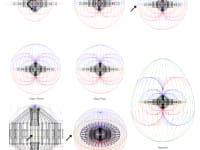Today, the demand for sustainable energy is crucial for tomorrow’s bright future. Tokamak-style machines claim to be futuristic superconducting batteries but, no perfected model has been achieved. The biggest limitation they’ll have when perfected is being stationary. Deep space exploration has 3-major challenges that need answers first; electrical power, shielding protection, and cheap reliable propulsion. My diamagnetic field engine (DFE) transforms into a superconductor to create power, protection, and propulsion. DFEs use 2-diamagnetic field capacitors (DFC), 1-NDFC and 1-SDFC. Each DFC has 6 magnetized pieces; 1-primary (piston) and 5-barrier (1-release plate and 4-quarter circular segments). If the piston’s internal dipole is north, then it’s a NDFC, if the south dipole’s inside then it’s a SDFC. DFEs are supported by a frame and shell. The shell is a barrier that assists with start-up. The configuration of each DFC's diamagnetically pressurizes the capacitor to force the piston’s internal magnetic field to reduce to a string-like structure within the capacitor. Hydraulic arms attach the release plate to a compression plate that’s holding the piston in order to pull the piston deeper into its capacitor.
When the engine is off, both pistons touch, to start, 4-steps must be achieved. Step-1 is diamagnetic compression to both DFCs simultaneously at a constant rate to form electrical resistance. Resistance forms an electrical core within each capacitor and will dissipate if all 4-steps aren't reached. Resistance has to increase until step-2’s paramagnetic attraction, aligning external field lines with different magnetic polarity to open the first electrical gateway allowing the north current to pass through the SDFC, and vice-versa. As both currents enter their opposite capacitor, they entangle to that capacitor to achieve step-3, dipole entanglement connects separated pistons with an electrical arc to open the second electrical gateway that leads the north current back to the NDFC to cancel-out step-1 as the third electrical gateway at the original core. Each core’s purpose is no-longer needed to increase electrical mass but, to exist to maintain the present loop cycle’s current density. As each current begins to complete a second loop, they have to pass through step-4, dipole cancellation entanglement. Step-4 cancels out step-2 by increasing electrical resistance to form a radial core required to close the entangled loop cycle. With 2-separated electric cores, 1-electrical arc, and the radial charge all emitting light waves, zero electrical resistance is achieved by forcing the electrically increased expulsion of magnetic flux to wrap around to form a closed curve.
As a superconducting battery, a packet is sent and received at the same time due to the engine’s entanglement cycle. If any electrical packets are removed from the present cycle, resistance increases and then decreases back to zero as new packets are created to replace lost packets in order to hold zero electrical resistance. Achieving step-4 places the engine into a state of inertia damper with a surrounding protection field. By transfer compression to the bottom capacitor increases that current emerging from the SDFC and provides thrust propulsion. Add counterweights and landing-appendages, now go explore.
Like this entry?
-
About the Entrant
- Name:Brian Goodman
- Type of entry:individual
- Patent status:none








